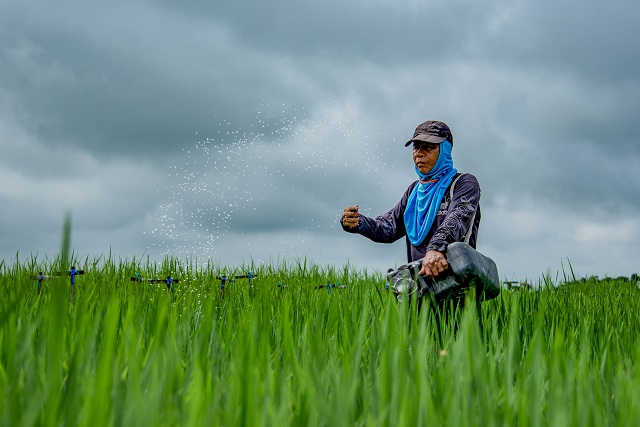
To help the farmers increase crop yields amidst the skyrocketing price of fertilizer in the global market, the Department of Agriculture (DA), through the Philippine Rice Research Institute (PhilRice), is promoting the use of biofertilizers and biostimulants in combination with inorganic fertilizer.
In a fertilizer derby, conducted by DA-PhilRice, results showed that the combinations of biofertilizers and/or biostimulants with inorganic fertilizers in the three to four seasons resulted in high yields while lowering the fertilizer cost per kilo of palay produced.
“We need more production of scientifically tested biofertilizers as we are concerned that the Ukraine-Russia war will disable us from getting the much-needed urea our farmers are clamoring to obtain,” said Agriculture Secretary William D. Dar.
“Biofertilizer products, such as the ones used in the trials are the technologies that we need in our campaign for balanced fertilization, the main focus of which is to enhance soil-based productivity, bringing about nutrient-building qualities of the soil for soil sustainability,” he added.
In the PhilRice trial, one combination resulted in 7 tons/hectare (t/ha) produced at P7.77/kg. The cost amounted to P2,000/ha in addition to inorganic fertilizers. Another combination resulted in 6.73 t/ha with P8.18 cost/kg while one combination yielded 6.35 t/ha at P7.71 cost/kg. All three products performed better during the dry season with an average yield of 7.91 t/ha at P7.33 cost/kg and during the wet season with 5.22t/ha yield at P8.58 cost/kg.
Participated by mostly private companies, the derby aims to determine the best nutrient management technology package to achieve high yield at least cost in a profitable and environmentally-sound manner. The technology packages of most participants included a combination of inorganic fertilizers and other products such as biofertilizers and biostimulants, soil conditioners, and micro-elements for foliar applications.
According to PhilRice, the current cost of using biofertilizers/biostimulants ranges from P900 to P6,900 per hectare depending on the number of applications.
Leylani Juliano, one of the project leaders cited that the first product’s composition based on the analysis provided by the Fertilizer and Pesticide Authority (FPA) included brassinosteroid, triacontanol, small concentrations of other elements such as iron, potassium oxide, copper, zinc, Vitamin B1, B2, B6, and has a liquid concentrate microbially synthesized from plant materials.
The second product is a mix of organic materials and root exudates or fluids, which the manufacturing company claimed can create healthy soil by increasing the presence of beneficial bacteria and fungi and will inhibit population of harmful microbes in the soil.
The third product is a nanobiofertilizer, which contains nitrogen, phosphate, soluble potash, other materials such as algae, bacteria, fungi, sea kelp, mineral electrolytes, and humic & fulvic acids. Except for the first product, these products reduced the use of inorganic fertilizer by 25-50 percent.
Juliano elaborated that in most cases, various materials can be used as biostimulants/biofertilizer such as algae extracts, humic acids, enzymes, hormones, and plant growth-promoting microorganisms.
“Various researches show that natural biostimulants can enhance nutrition efficiency in plants and overall plant growth as well as improve soil conditions to boost the growth of the rice plants,” Juliano said.
Other combinations achieved an average yield of 5.83 t/ha – 6.25 t/ha with average production cost of P7.79/kg – P8.08/kg of paddy produced in the three to four seasons of the derby. The derby’s fifth season is ongoing.
“With the global price hike of fertilizer due to the ongoing Ukraine crisis, the DA welcomes more options of fertilizer and other inputs to augment fertilizer availability while pushing for balanced fertilization strategy,” the agri chief said.
Secretary Dar has been a long-time advocate of balanced fertilization, stressing that to attain the maximum potential of farmlands, a judicious combination of organic and inorganic inputs is necessary. [by PhilRice/DA StratComms]




